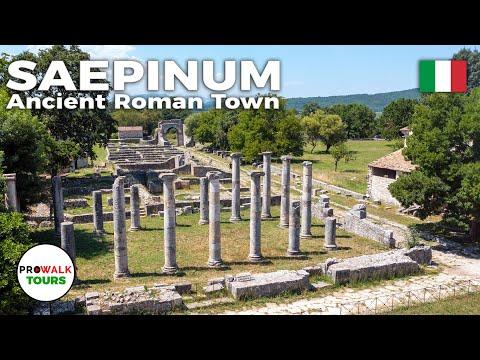Saepinum Walk
I stood at the edge of the ancient Roman town of Saepinum, a place that seemed like it had stepped straight out of a history book and into my reality. The sun was beginning its slow descent behind the distant mountains, casting long shadows that seemed to dance across the ruins. The air was crisp and filled with the earthy scent of aged stone and moss, and I couldn’t help but feel a twinge of excitement mixed with awe as I prepared to explore the site.
As I began my walk through Saepinum, the first thing that struck me was the vastness of the place. The cobblestone streets stretched out before me, perfectly preserved and seemingly untouched by time. I ran my fingers over the weathered stones, feeling their rough texture and imagining the countless footsteps that had worn them down over the centuries. The grandeur of the town was undeniable, even in its state of disrepair. Columns and arches, though partially crumbled, still stood as silent sentinels of a bygone era.
I made my way towards the town’s main thoroughfare, a broad avenue flanked by the remnants of impressive buildings. The road was paved with large, flat stones, some of which were engraved with ancient inscriptions. Each step I took echoed slightly, a soft reminder of the bustling activity that once filled these streets. The setting sun illuminated the scene in a warm, golden light, making the stones seem to glow with an ethereal beauty.
The Forum was my first major stop. It was here that the heart of the town’s social and political life had once beat. Now, it was a sprawling open space, dotted with the remains of various structures. The Basilica, with its grand columns and partially intact walls, stood at one end of the Forum. I imagined it as a place where people had gathered to discuss important matters, seek justice, and exchange news. The thought of the many lives that had intersected here made the space feel alive in a different, almost spiritual way.
Nearby, the remains of the amphitheater loomed, its arches partially collapsed but still impressive. I could picture the roaring crowds and the vibrant spectacles that had taken place within its walls. Walking around the perimeter, I saw the seating areas where spectators would have cheered for their favorite gladiators or marveled at dramatic reenactments. The silence that surrounded me now was profound, a stark contrast to the noise and excitement that had once filled the arena.
As I ventured further, I stumbled upon a narrow alleyway that led to a smaller, quieter part of town. Here, the buildings were less grand, but their charm lay in their simplicity. This seemed to be where the daily life of the townspeople had played out—homes, small shops, and modest baths. The walls of the houses were adorned with faded frescoes, their colors still vibrant despite the ravages of time. I could almost hear the murmur of conversations and the clinking of pottery as I imagined the people who had lived here.
One particular house caught my attention. It had a small courtyard in the center, surrounded by columns and partially intact mosaics on the floor. The mosaic depicted a scene of daily life, with figures engaged in various activities. It was as if the artist had frozen a moment in time, capturing the essence of what it meant to live in Saepinum. I stood in the courtyard, feeling a deep connection to the past, as if the people who had walked here were somehow still present, sharing their stories with me.
As night fell, the temperature dropped, and the once warm light of the setting sun was replaced by the cool, silvery glow of the moon. The ruins took on a different character under the moonlight—mysterious and almost magical. I found a spot on a rise overlooking the Forum and sat down to take in the view. The silence was profound, broken only by the occasional rustle of leaves and the distant call of a night bird. It was a moment of pure tranquility, a chance to reflect on the beauty and history that surrounded me.
My mind wandered back to the people who had once called Saepinum home. I wondered about their daily lives, their hopes and dreams, and how they had experienced the world around them. The town had been a thriving community, a hub of activity and culture. Now, it was a poignant reminder of the passage of time and the impermanence of human endeavors. Yet, in its quietude and beauty, Saepinum had a way of making the past feel incredibly present.
As the stars began to shine brightly in the clear night sky, I reluctantly prepared to leave. My walk through Saepinum had been more than just a physical journey through ancient ruins; it had been a profound exploration of history, memory, and connection. The town had given me a glimpse into a world long gone, yet somehow still very much alive. As I made my way back to the modern world, I carried with me a sense of wonder and a deeper appreciation for the echoes of the past that linger in the present.
